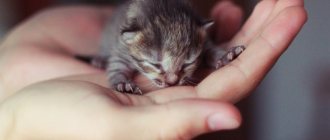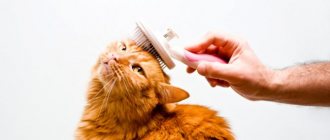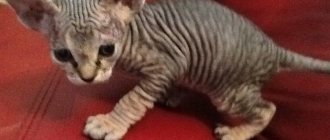11634Administration
3
When the touching moment comes of the appearance of a couple of months old fluffy ball in the house, a huge responsibility immediately falls on the shoulders of its new owners. And those who believe that it is enough to “feed and put the baby to sleep” are deeply wrong.
Caring for a 2-month-old kitten means not only providing a roof over your head, food and a cozy place, but also many procedures to maintain your pet’s health:
- developing a diet special for a 2-month-old baby;
- toilet training, litter box care;
- care for teeth, ears and eyes;
- vaccination;
- nail care;
- the washing up;
- grooming (especially if the kitten has long hair);
- games.
All this must be done so that the kitten at 2 months is truly well-groomed, healthy and feels love from its new family.
Diet
Nutrition for a two-month-old kitten is a powerful guarantee of its energy, activity and overall health.
Therefore (regardless of the breed) the baby must be fed fully. A well-designed menu is a mandatory inclusion in the pet’s diet of necessary products or truly healthy food, as well as the refusal of food that is harmful to the kitten, which can seriously undermine its health.
© shutterstock
General feeding recommendations
If a kitten is switched to natural feeding, food from the owner’s table should under no circumstances be offered to it. You will have to cook individually for your pet. Lean meat and poultry, fermented milk products, vegetables, grains (including sprouted ones) will be very useful; sometimes you can offer sea fish (also not fatty).
You should not treat your pet to ocean fish, any bones, whole milk, potatoes and pasta, and also exclude salty, smoked and spicy foods.
A 2 month old kitten should receive food 5-6 times a day. At the same time, food should not be cold or hot, or salty. Products must only be fresh.
If feeding a kitten at 2 months is based on ready-made food, the following conditions must be met:
- You only need to buy packages marked “for kittens.”
- The food should not be cheap (it does more harm than good) or canned (such food can be given to an adult cat).
- Ideally, purchase products from one manufacturer so that the kitten already eats a balanced diet at 2 months.
- It is forbidden to mix dry and wet food: digesting each of them takes different times, and it will be very difficult for a small stomach to cope.
- If the “drying” is too large, it is better to soften it in water until it becomes mushy.
Water must be available at all times, especially when using ready-made dry food. The water is changed once a day for fresh water.
The dishes must also be taken care of. You need to wash it often so that leftover food does not dry out in it and spoil. Ideally, immediately after the kitten has eaten. Bowls should be stable and heavy (so that they do not crawl away from the pet while eating).
Raising a pet
If caring for newborn kittens requires complete rest, then the owner should devote more time to older babies - pick them up, accustom them to a daily routine, caress them and play. Kittens with whom a person spends enough time grow up affectionate and fearless, while babies who do not receive proper attention grow up semi-wild and too independent.
Games with a kitten
By nature, cats are nocturnal animals, so at first the kitten will be most active at night. We will have to accustom him to a daily lifestyle. To do this, all games must be played during the day or in the morning.
Cats are predators, so for best development, all games should reproduce the hunt. For example, you can tie a candy wrapper to a string and pull it in front of the kitten’s nose. He will quickly become interested in the rustling toy. Sometimes it’s worth giving in and letting him catch the “prey.” Playing with a laser pointer is also very interesting - both the owner and the kitten will enjoy it.
An unattended kitten can cause a lot of trouble.
Never pull out the toy too sharply, otherwise you can damage the claws that the kitten actively uses during play. Do not squeeze or hurt the baby - negative sensations will quickly turn the baby away from playing and interacting with the owner in general.
At the age of 2-6 months, small kittens play a lot - up to 50-60% of wakefulness. Moreover, this does not depend on human participation. If the kitten is not given due attention, he looks for fun on his own, and it may not always be pleasant. In order to avoid danger to both property and the kitten, you need to play with it for at least 1.5–2 hours a day. You should play until the cub begins to feel short of breath. If it appears already in the first minutes of the game, this is a reason to contact a veterinarian.
Pet stores offer a wide range of educational toys for kittens, such as tracks, game discs, track towers or puzzle boxes.
Photo gallery: educational toys for kittens
In the educational track there are places covered with a lid, the kitten will have to think about how to get the ball out of there. The simplest track with balls, combined with a scratching post
Here the bait jumps out of the holes, the kittens hunt for it with great pleasure
Such a toy will teach a kitten, oddly enough, thinking, because in order to extract a treat, you need to do a certain action with the toy. Balls moving along the “floors” delight not only kittens, but also adult cats
In such a toy, the bait suddenly jumps out of the holes, thus training the kitten’s reaction and dexterity
How to deal with fear and aggression
There are several reasons for the fear of a kitten:
- cats have such a feature as timidity during illness, therefore, if the kitten suddenly began to hide in secluded corners or be afraid, this is a reason to consult a veterinarian;
- the kitten may be afraid of a certain object, you should find out and eliminate the frightening object;
- It also happens that a kitten’s fear is innate, and it is possible to get rid of it only with the help of sedatives; Dr. Bach’s drops are very helpful.
Prevention and elimination of fear in a kitten involves the following actions:
- First of all, find out in which situations the baby is simply worried, and in which he experiences severe stress.
- Try not to place the kitten in stressful situations: if he is afraid of the vacuum cleaner, lock him in another room when cleaning, if he is afraid of the TV, move him to a room where there is none.
- Prevention of fear should start small. Choose a situation in which your baby is least afraid and carefully introduce it to it. For example, if your baby is afraid of people or touches, try to constantly be in the same room with him, treat him with treats and stroke him while eating.
- If the kitten has learned not to be afraid in the least stressful situations, then begin to accustom him to those in which he is more afraid. For example, if the noise of the blender causes him great fear, you should give him his favorite food while turning it on. Gradually, the blender will cease to be something terrible for him.
- Give the kitten as much attention as possible, play with it, pet it and talk to it. Often fear is associated with a lack of attention.
The baby’s fear can be dealt with with affection and gradual taming, as well as with drug therapy.
If the kitten is too aggressive, for example, in play or in contact with a person, then you can deal with this as follows:
- try to find a “golden mean” and not overdo it with the educational aspect, since the kitten may perceive your overly aggressive behavior in response as a signal that you are joining the game;
- pay enough attention to your pet;
- praise the animal when its behavior is good, and do not miss moments when the baby deserves to be scolded;
- remember that under any circumstances the use of brute force against an animal is unacceptable, this can only aggravate the situation;
- avoid stress for the kitten;
- provide the animal with a good scratching post;
- be consistent and constant, you cannot scold a kitten today for playing aggressively, and tomorrow allow him to behave with impunity;
- too severe punishments, such as spraying with water from a spray bottle, are possible only in extreme cases, when nothing helps, in such a situation, consult a veterinarian; the animal may need therapy with sedatives.
Moderate play aggression is normal for kittens
Pet safety
It is very important for a small kitten to ensure safety in a city apartment. You can do this by considering the following tips:
- It is better to keep very young kittens in one room. This way they will be in less danger and it will be easier to monitor them.
- Always check that the windows in your home are closed. A kitten can not only fall out of the window, but also get stuck in it. If you need to ventilate the house, kittens should be locked in a separate room.
- Wires also need to be carefully hidden. A kitten can receive a severe electric shock if the top layer of insulation is damaged.
- All small and breakable things must be hidden. There is a danger that the baby will swallow them or break them and get hurt.
- When you leave the house, make sure that the kitten does not slip into the entrance.
- When closing the doors, be very careful: you can easily break the kitten's tail by accidentally squeezing it.
- Check chairs or sofas before sitting on them - kittens can get under the covers.
- All toxic drugs and substances must be hidden.
- Before turning on electrical appliances, for example, a washing machine, oven, dishwasher, check them from the inside - the kitten loves to sleep in such places. If you keep your laundry in a basket before washing, you should also check it. Kittens can also get into the refrigerator, so check it every time before closing it.
- All kitten toys should be non-toxic and cannot be chewed or chewed. You should only play with toys on strings under supervision; alone, a kitten can become entangled in the string and suffocate.
Many indoor plants and flowers are dangerous for cats. Therefore, try to remove the following plants from the house where there is a kitten:
- spathiphyllum;
- ficus;
- dieffenbachia;
Dieffenbachia is a popular houseplant, but it is dangerous for cats.
- caladium;
- hydrangea (hydrangea);
- ivy (all poisonous species);
- azalea (rhododendron);
- Euphorbia (euphorbia);
- callas;
- snowdrops (water in which cut flowers have stood also becomes poisonous);
- daffodils;
- helleborus, or hellebore;
- oleander;
- lilies (these also include hyacinths and tulips), the pollen of these flowers is especially dangerous; if it remains on the fur and the kitten licks it, it can kill him;
- geranium (pelargonium);
- calendula (marigold);
- lily of the valley;
- chrysanthemum;
- violet;
- cyclamen.
The kitten carrier should be comfortable and spacious. It is better to carry babies together - this way they will be less afraid. You should not buy a carrier bag, as it will make the kittens hot and stuffy. A frame bag will not work either: it is also stuffy, and the kitten can get hurt if the frame breaks. The best option would be a plastic box. It is not only safe, but also provides kittens with normal temperature and ventilation.
Toilet training
In a new home, a small kitten may well “fine” out of habit, and this is forgivable at first. But it’s better to start accustoming him “to his place” on the very first day.
To do this, it is necessary to take proper care of the litter box: it should always be clean and large enough for the kitten to sit comfortably in it.
Also, when getting used to the toilet, special sprays will help, thanks to which the kitten will already be able to figure out “where it is possible and where it is not possible” already at 2 months:
- Training (spray directly into the tray).
- Repellent (apply to those places where the baby has done something wrong).
The main thing is not to scold or punish your pet for mistakes at first, and then, having felt kindness and patience on the part of the person, the kitten, even at 2 months, will quickly get used to the litter box.
© shutterstock
Caring for newborn kittens
Bed. A newborn kitten needs round-the-clock care, especially if it is left without a mother cat. His “nest” should be equipped with a warm bed. For this, use a warm heating pad. It is placed in a basket or box where the baby sleeps. An alternative could be a plastic bottle filled with warm water (approximately 36-38 degrees) and wrapped in a cloth. After two weeks, the temperature is reduced to 28 degrees, and after another week - to 24 degrees. Caring for a kitten with a heated bed is extremely important if it is a small Sphynx or any other hairless member of the cat family.
Nutrition. If a cat feeds its cubs milk, then they begin to feed them natural food only in the fourth week of life. Caring for a newborn kitten left without a mother is a little more difficult. The baby should receive food every 2.5 hours, even at night. They feed him using a pipette or a bottle with a nipple attached to the spout. The container is sterilized after each feeding, and a fresh portion of milk food is prepared each time. The orphan is fed with a special cat's milk substitute, which is sold in pet stores. Temporarily, you can use rice water for feeding.
Hygiene. Around the eighth day of life, kittens open their eyes. If this event drags on, you should contact your veterinarian. With a simple procedure, it will help your eyelids open. By day 14-15, kittens can already hear fully, and by day 20 they begin to move independently. At this time, caring for the kitten consists of simple hygiene procedures that are aimed at preventing inflammation. If a kitten grows up without a mother, then to imitate licking, wrap it in a damp linen napkin and lightly massage its tummy. This massage improves the digestion of a newborn kitten and helps to go to the toilet.
Teeth cleaning
2 months is the age when it is easiest to teach a kitten to brush its teeth. The later you start, the more difficult it will be to force your pet to endure the execution.
It is enough to take care of your pet’s teeth only 1-2 times a month; the rest of the time, the kitten cleans off the plaque itself by gnawing on solid food (dry croquettes, chicken or meat cartilage, etc.).
When caring for your teeth, it is better to use special brushes and pastes with the smell and taste of your favorite foods that are attractive to pets, as this makes it much easier to get used to the procedure. You can buy everything you need at veterinary pharmacies.
Advice: it is better to end each dental care session with praise and treats to reinforce the training effect.
Baby's daily routine
Pediatricians recommend adhering to a certain daily routine for the baby, but do not forget that all children are individual. Always listen to your child. It will take some time before the baby develops a certain routine that will satisfy both himself and his parents.
Walking with your baby
The first walk with your baby, regardless of the time of year, should last no more than 20 minutes. After this, you can add 5-10 minutes every day, bringing the total time to 1 hour. Then the walking time will depend on the weather and the wishes of the parents. If it is too hot or cold outside (below -10 degrees), the walk should be postponed to a more favorable time.
Many parents are accustomed to combining walks, especially in winter, with the baby's sleep. In fact, such a walk has much less benefit. Why is this happening?
During sleep, the child's immunity decreases. If you regularly practice sleeping in the cold, phagocytosis will decrease. As a result, the baby will suffer from colds and viral infections more often.
It is best to go for a walk with an awake and active child before bed or after waking up. If it is raining, strong wind or snowing outside, you can also walk on the balcony.
How to dress a child under one year old?
How to dress your baby depends on the ambient temperature and weather conditions. You can rely on the following examples:
- +21 and above. Lightweight panama hat and short sleeve bodysuit.
- +20…+17 degrees. A thin panama hat or hat, a light cotton slip and a fleece overall.
- +15…+10 degrees. Light cotton hat, cotton slip, fleece overalls, envelope or jacket, depending on age.
- +10…0 degrees. Underwear set, fleece overalls, cotton hat with lining, warm overalls or envelope.
- 0…-10 degrees. Cotton underwear, thermal underwear, helmet hat, fleece overalls, overalls and envelope.
Sleep and wakefulness
A proper sleep and rest schedule is very important for a child in the first year of life. This mode may look like this:
- 1 month. During the day, a baby can sleep from 4 to 8 times. The duration of night sleep is from 8 to 10 hours. The total number of hours of sleep is 16-19.
- 2-3 months. The number of daytime dreams is 3-5. The duration of night sleep is 10-11 hours. The total number of hours of sleep per day is 17-19.
- 4-5 months. The number of daytime dreams is 4-5. The duration of night sleep is 10-12 hours. The total number of hours of sleep is 14-17.
- 6-8 months. The number of daytime dreams is 2-3. The duration of night sleep is 10-12 hours. The total number of hours of sleep per day is 12-15.
- 9-11 months. Number of daytime sleeps - 2. Night sleep - 10-12 hours. The total duration of sleep per day is 12-14 hours.
For a one-year-old child, one nap during the day is considered the norm. However, he can also wake up at night. This is an approximate sleep pattern for infants. If your baby lives in a different mode, it's okay. Most importantly, do not forget that proper rest is extremely important for a growing body.
Eye cleaning
A healthy kitten's eyes are always moist. But if dry crusts appear in the inner corners, pus is a sign of disease. In this case, eye care is necessary. The accumulations are removed with a napkin soaked in boric acid or in a solution of furatsilin (as prescribed by a veterinarian) in the direction from the outside to the nose.
With normal lacrimation, eye care does not require special products from the pharmacy. It is enough to rinse in the same direction (towards the nose) with regular tea leaves or chamomile decoction.
Advice: when carrying out the procedure, it is better not to use cotton swabs or pads, as individual fibers get into the eyes and cause discomfort, which will make further eye care problematic.
Caring for a one-month-old kitten
Nutrition. By the fifth week, the kitten already weighs 240-260 grams. For weight gain to be physiological, the feeding interval, starting from the fourth week, should be 3-4 hours. Food is provided only during the daytime. In addition to milk, the diet of a one-month-old kitten includes lean beef, turkey, canned food for kittens, and vegetable puree. All solid ingredients must be ground until homogeneous, because babies are not yet able to chew food.
global $ads_google; //data-ad-slot=”2475549904″ $ads_google = empty($ads_google) ? false : true; ?> if ($ads_google == false) {?>
$ads_google = true; ?> } ?>
Toilet. At 1 month, you can place a tray next to the bed. It is necessary to place the baby in the container after each meal. To begin with, you can put disposable absorbent diapers in the tray. After some time, filler is poured in instead. It is important to ensure that the kitten does not eat lumps and granules from the tray.
Hygiene. A one-month-old cat cannot be bathed yet. Care procedures consist of regular examination and washing of the eyes and ears. To do this, use a cotton pad soaked in warm water. Sometimes kittens experience watery eyes in the morning. If there are no suspicious purulent impurities in the discharge, then regular washing with water is sufficient.
When caring for a small kitten, you should pay attention to the gums. If they become red and swollen, a teething numbing gel should be used.
Ear cleaning
Ear care for kittens at 2 months does not need to be done frequently, as their shells are usually still clean. But checks for the presence of earwax (dark spots) should be carried out from time to time. Dirt should be removed as needed with a cotton swab lubricated with oil or cosmetic Vaseline.
When cleaning, you should not try to insert the stick deep into the ear; it is enough to remove accessible stains. When carried out properly, almost every kitten tolerates the procedure calmly . This procedure is not only hygienic, but also an excellent preventive measure against ear mites. Cleaning should be done individually (depending on how dirty it is), but on average – once a month.
© shutterstock
Essentials
Food bowls
Pet stores offer a wide selection of food bowls. Plastic cups are the most affordable, but require frequent replacement. British kittens can knock them over, dirtying the floor. Ceramic bowls are attractive to look at and durable, but they break easily and are expensive. Metal cups are easy to care for, durable, and inexpensive.
Sleeping area
It is important for Scottish Fold kittens to feel safe both while awake and while sleeping. Therefore, it is recommended to arrange a special place for their rest.
It could be:
- a soft small mattress laid on the floor or low bedside table;
- bed with sides;
- closed house;
- a cat complex consisting of a shelter, steps, scratching posts, playgrounds and rest areas.
This is interesting: Why does the cat's belly hang?
Claws
In principle, you can do nothing at all with claws, if you don’t feel sorry for the furniture upholstery. Otherwise, you will have to wean your pet from the habit of tearing up everything. You can do this in several ways:
- buy a scratching post, spray it with catnip that is attractive to these pets, and teach how to use it by smoothly running your paws with extended claws over the surface of the device (often scratching posts are already sold impregnated with special compounds to attract the attention of cats);
- put caps on the claws and monitor the kitten’s reaction (whether it will be comfortable for him to wear them);
- trim the claws, cutting the length no more than 1 mm from the edge, so as not to cause pain to the kitten.
These measures will be enough to try to protect furniture upholstery and wallpaper from tearing.
Toys and other things for development and communication with a kitten
Don't forget about kitten toys. When buying toys, choose soft ones made from elastic materials. These can be balls, fur balls, mice and much more. The main thing is that the toy does not have small parts that the animal can tear off and accidentally swallow.
Don't forget, a cat is a predator, it needs to constantly play, hunt, tumble and climb. An active lifestyle allows the animal to be active and in good health. This is especially true for kittens, because in the process of play they develop their dexterity, flexibility and muscle activity. All this allows the kitten to grow and develop harmoniously.
To avoid trouble with damaged furniture, be sure to buy a scratching post. It is impossible to wean an animal from this; it is in its genes, because this is how they take care of their claws and grind them down. So just give your kitten a special place to sharpen his claws.
the washing up
There is no need to wash your pet often; once every 1 or 2 months is enough. In order for the kitten to get used to water faster, it is important to provide him with comfortable washing:
- lay a rag on the bottom so that the paws do not move apart;
- make the water temperature about 38 C;
- depth - to the middle of the paws;
- the stream should be thin;
- be sure to stroke and talk to your pet affectionately (since the first bath can frighten the baby);
- Use a special shampoo for cats and rinse it off thoroughly.
The basic rule is that when washing, do not wet the kitten’s head, ears and eyes . After the procedure, wrap the animal in a soft towel and dry the fur, and then do not let the dry pet into drafts.
© shutterstock
Caring for your pet's health: advice from a veterinarian
Recommendations are given by S.V. Mukaseev, veterinarian of the SKiFF Research and Production Company.
The most important task of a kitten owner is to protect the animal from parasites. Worms are deadly for small kittens. The larvae of these parasites can enter the kitten’s body in the womb or through her milk during suckling. Even a domestic cat is not immune from helminth infection.
Experienced owners and breeders use the broad-spectrum anthelmintic drug Prazitel to prevent internal parasites. This drug is recommended for use by veterinarians.
Prazitel suspension for cats and kittens
Wool
Shiny and soft fur is an indicator of the health of the animal. In order for her to always look “excellent”, she will need comprehensive care:
- balanced diet;
- keeping the kitten clean (timely washing);
- and actually caring for your pet’s fur coat – combing with special combs and combs (not human ones).
To care for a 2-month-old kitten’s fur, it is important to meet all of the above conditions.
Recommendation: a comb, with its teeth, penetrates the hair much deeper than a comb, so when using it, you should not apply pressure.
Is it necessary to swaddle a baby?
The question of the need for swaddling still remains open. Proponents of “tight” swaddling cite the following arguments in favor of this decision:
- A wrapped baby calms down faster and sleeps more soundly.
- A diaper wrapped around the body provides tactile sensations.
- A baby feels less cold in a diaper.
“Free” swaddling is also possible. In this case, the diaper does not hinder the movements of the arms and legs. The advantages of this method are:
- Freedom of movement.
- Good air circulation between skin and fabric.
- Teaching a child to sleep without diapers.
Some parents refuse swaddling from birth, leaving the baby to sleep in light clothing.
Important! The question of the need for swaddling is individual for each parent. It is important to take into account the individual characteristics of the child’s body. If the baby sleeps peacefully and does not toss and turn, he does not need to be swaddled from the first days.
Activities with the baby in the first year of life
Activities with your child should be selected according to his age. In this case, you must remember the following rules:
- Engage your child regularly from birth.
- Choose the same time to study. It is best to practice in the morning or early afternoon.
- Try to interest the baby.
- The younger the child, the shorter the duration of the lesson.
You can go without toys for up to 3 months. During this period, the baby learns to concentrate. He is attracted to different sounds, bright colors and familiar faces. The older a child gets, the wider his range of interests.











